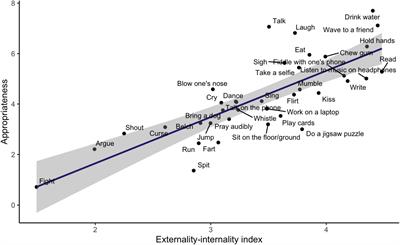5
IntroductionA crucial aspect of social norms pertains to determining which behaviors are considered appropriate. Here we consider everyday behaviors. Some everyday behaviors are rated as more appropriate than others, and ratings of the appropriateness of a given behavior may vary over time. The objective of this study is to elucidate the reasons behind variation in appropriateness ratings of everyday behaviors in the United States. Our theory focuses on how the evaluation of the appropriateness of a behavior is influenced by its potential for externalities and internalities, and how this influence may cause a change in norms over time.MethodEmploying a preregistered design, we asked American participants to rate 37 different everyday behaviors based on their appropriateness in a range of common situations, as well as their potential negative externalities (e.g., being loud, being aggressive, taking up space) and positive internalities (e.g., pleasurability). Changes over time were calculated as the difference between mean ratings obtained in this study and ratings of the same behavior in a similar study conducted 50 years ago.ResultsAs expected, overall appropriateness ratings of everyday behaviors are associated both with their externalities and their internalities, so that the least appropriate behaviors tend to have considerable potential for negative externalities and little potential for positive internalities. Moreover, behaviors that have considerable potential for ...



2 comments, and one is Rimworld? I wish I had more hands! Up up up!